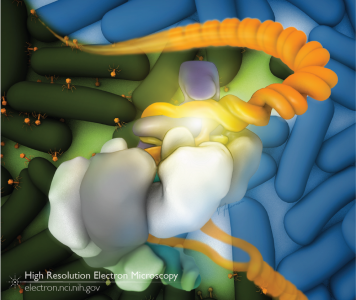CRISPR systems are well known for their use as DNA editors in the lab – but these complexes evolved in bacteria as a way for the cells to defend themselves against invading viruses. Although these systems are highly diverse – CRISPR complexes have evolved to handle a variety of RNA and DNA elements – they generally use similar mechanisms to specifically recognize and eventually degrade invading viral genetic material.
In our 2017 study published in Cell, we used cryo-EM to determine the structure of the Pseudomonas aeruginosa Type I-F CRISPR surveillance complex (Csy) bound to a double-stranded DNA template. Our structure revealed the path of the target DNA strand, starting from the recognition site (where the two DNA strands are separated) and continuing its path along the backbone of the Csy complex bound to the complementary CRISPR RNA. At the DNA fork, we found a “hook” that turns down to hold the DNA in place. A comparison of this structure with the unbound form shows that the DNA bound form of the Csy complex is stretched along its axis, which might allow access to nucleases that can degrade the DNA.
In the same study, we also imaged Csy with several inhibitors, which are employed by viruses to overcome the CRISPR system. Each inhibitor worked in a unique way to interfere with the ability of the CRISPR system to bind with the target DNA strand: some bound to the belly of the complex, blocking the DNA interaction with the CRISPR RNA, while others bind closer to the fork, blocking the interaction between the DNA and the Csy “hook”.
The artwork above shows the Csy complex bound to DNA (orange); the DNA fork is coordinated by the “hook” (purple), overlaid on a field of healthy (blue, upper right background) and virally infected (green, lower left background) bacteria.
Full-size image: Download (1MB) | View animation
Related Reference: Guo TW, Bartesaghi A, Yang H, Falconieri V, Rao P, Merk A, Eng ET, Raczkowski AM, Fox T, Earl LA, Patel D, and Subramaniam S. Cryo-EM Structures Reveal Mechanism and Inhibition of DNA Targeting by a CRISPR-Cas Surveillance Complex. Cell. 2017 Oct 5. doi: 10.1016/j.cell.2017.09.006. [PubMed]
